Public Health's Role in Health and Social Care: A Comprehensive Report
VerifiedAdded on 2021/02/22
|13
|4442
|62
Report
AI Summary
This report provides a comprehensive overview of the role of public health in health and social care within the UK. It begins by examining the functions of various agencies, such as the WHO, UK Department of Health, and local authorities, in identifying and addressing community health and disease levels. The report then delves into infectious and non-infectious diseases prevalent in the UK, including HIV and diabetes, and explores strategies to control disease incidence, such as surveillance, screening, immunization, education, and environmental controls. Furthermore, it analyzes current priorities and approaches in providing services for individuals with diseases or illnesses, including primary, secondary, and tertiary prevention strategies for HIV. The report also discusses the relationship between disease prevalence and service requirements, emphasizing the importance of data and information in planning effective prevention programs. Finally, it assesses the impact of current lifestyle choices on future needs for health and social care services, highlighting factors such as diet, working culture, and substance use.
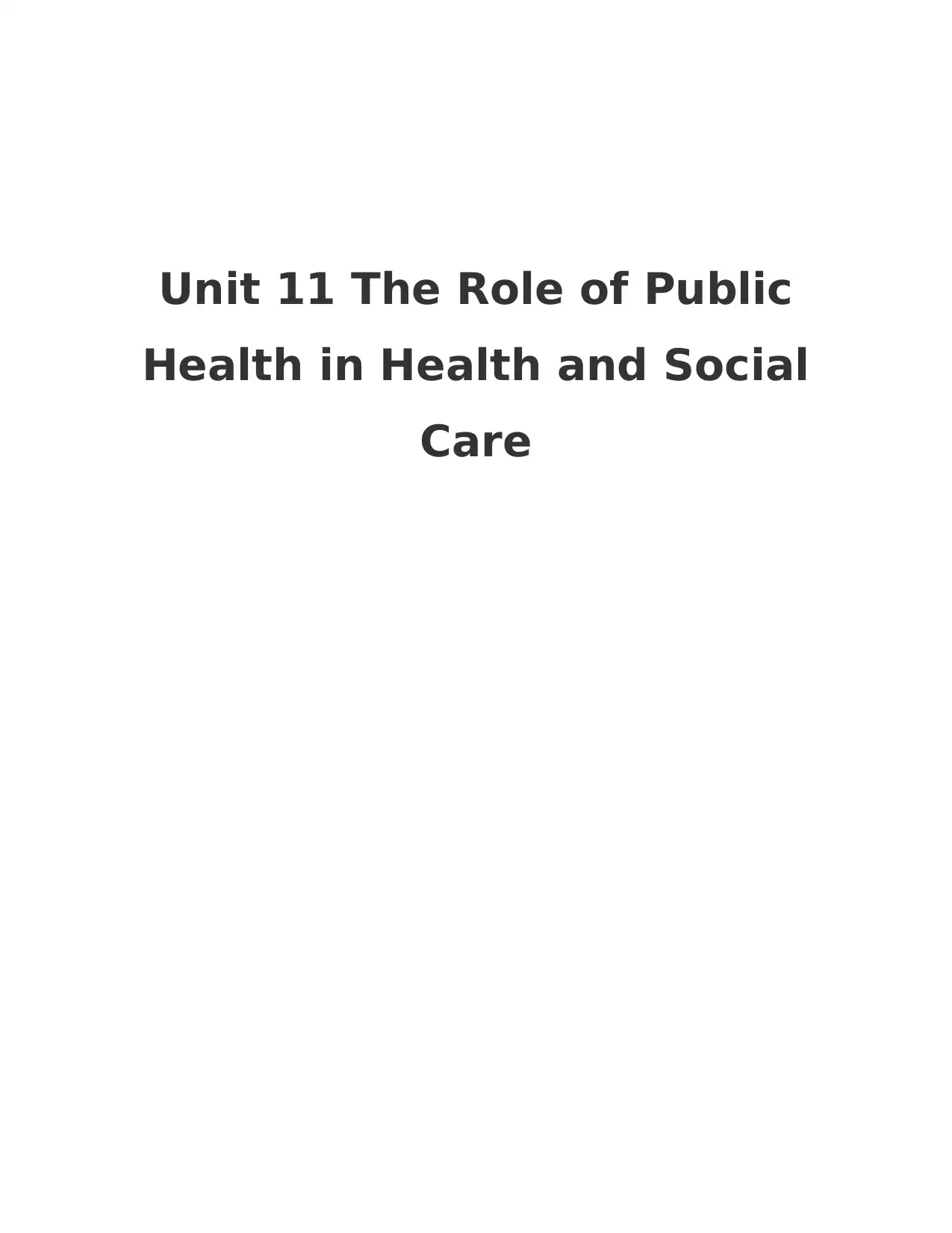
Unit 11 The Role of Public
Health in Health and Social
Care
Health in Health and Social
Care
Paraphrase This Document
Need a fresh take? Get an instant paraphrase of this document with our AI Paraphraser

Table of Contents
INTRODUCTION...........................................................................................................................3
LO1..................................................................................................................................................3
1.1 Role of different agencies identifying levels of health and disease in communities.............3
1.2 Infectious and non- infectious Disease in UK.......................................................................4
1.3Effectiveness of different approaches and strategies to control the incidence of disease in
communities.................................................................................................................................4
LO2..................................................................................................................................................5
2.1 Current priorities and approaches to the provision of services of people with disease or
illness...........................................................................................................................................5
2.2 Relationship between the prevalence of disease and requirements of services to support
individuals....................................................................................................................................6
2.3 The impact of current lifestyles choices on the future needs for health and social care
services.........................................................................................................................................7
LO3..................................................................................................................................................8
3.1 The health and well-being priorities for individuals..............................................................8
3.2 Effectiveness of strategies, systems and policies in a health or social care settings.............8
3.3 changes that could be made to improve the health and well-being of individuals ...............9
3.4 Numerous activities that are being implemented to support behavior change for improve
living of people in a healthy manner..........................................................................................10
CONCLUSION..............................................................................................................................10
INTRODUCTION...........................................................................................................................3
LO1..................................................................................................................................................3
1.1 Role of different agencies identifying levels of health and disease in communities.............3
1.2 Infectious and non- infectious Disease in UK.......................................................................4
1.3Effectiveness of different approaches and strategies to control the incidence of disease in
communities.................................................................................................................................4
LO2..................................................................................................................................................5
2.1 Current priorities and approaches to the provision of services of people with disease or
illness...........................................................................................................................................5
2.2 Relationship between the prevalence of disease and requirements of services to support
individuals....................................................................................................................................6
2.3 The impact of current lifestyles choices on the future needs for health and social care
services.........................................................................................................................................7
LO3..................................................................................................................................................8
3.1 The health and well-being priorities for individuals..............................................................8
3.2 Effectiveness of strategies, systems and policies in a health or social care settings.............8
3.3 changes that could be made to improve the health and well-being of individuals ...............9
3.4 Numerous activities that are being implemented to support behavior change for improve
living of people in a healthy manner..........................................................................................10
CONCLUSION..............................................................................................................................10
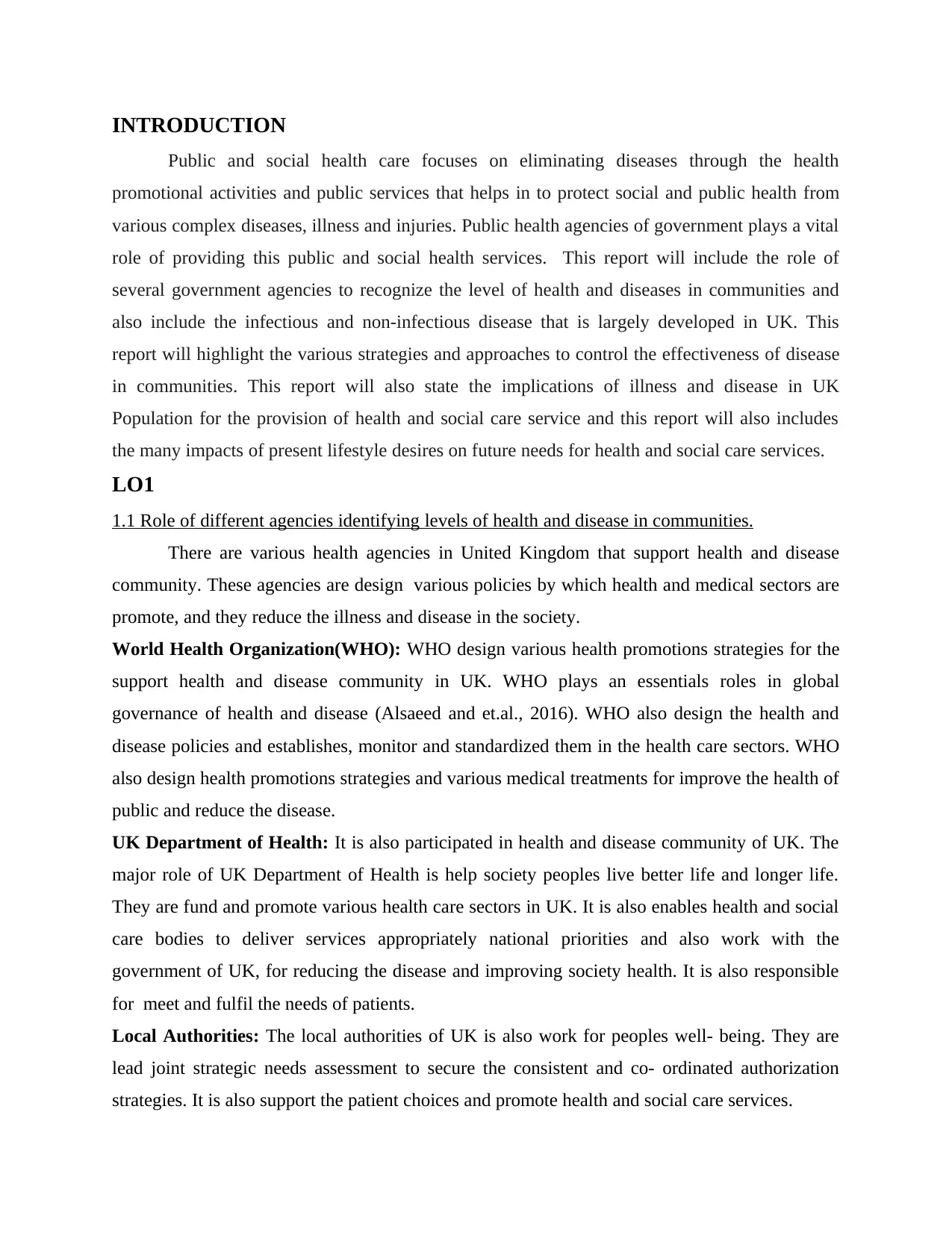
INTRODUCTION
Public and social health care focuses on eliminating diseases through the health
promotional activities and public services that helps in to protect social and public health from
various complex diseases, illness and injuries. Public health agencies of government plays a vital
role of providing this public and social health services. This report will include the role of
several government agencies to recognize the level of health and diseases in communities and
also include the infectious and non-infectious disease that is largely developed in UK. This
report will highlight the various strategies and approaches to control the effectiveness of disease
in communities. This report will also state the implications of illness and disease in UK
Population for the provision of health and social care service and this report will also includes
the many impacts of present lifestyle desires on future needs for health and social care services.
LO1
1.1 Role of different agencies identifying levels of health and disease in communities.
There are various health agencies in United Kingdom that support health and disease
community. These agencies are design various policies by which health and medical sectors are
promote, and they reduce the illness and disease in the society.
World Health Organization(WHO): WHO design various health promotions strategies for the
support health and disease community in UK. WHO plays an essentials roles in global
governance of health and disease (Alsaeed and et.al., 2016). WHO also design the health and
disease policies and establishes, monitor and standardized them in the health care sectors. WHO
also design health promotions strategies and various medical treatments for improve the health of
public and reduce the disease.
UK Department of Health: It is also participated in health and disease community of UK. The
major role of UK Department of Health is help society peoples live better life and longer life.
They are fund and promote various health care sectors in UK. It is also enables health and social
care bodies to deliver services appropriately national priorities and also work with the
government of UK, for reducing the disease and improving society health. It is also responsible
for meet and fulfil the needs of patients.
Local Authorities: The local authorities of UK is also work for peoples well- being. They are
lead joint strategic needs assessment to secure the consistent and co- ordinated authorization
strategies. It is also support the patient choices and promote health and social care services.
Public and social health care focuses on eliminating diseases through the health
promotional activities and public services that helps in to protect social and public health from
various complex diseases, illness and injuries. Public health agencies of government plays a vital
role of providing this public and social health services. This report will include the role of
several government agencies to recognize the level of health and diseases in communities and
also include the infectious and non-infectious disease that is largely developed in UK. This
report will highlight the various strategies and approaches to control the effectiveness of disease
in communities. This report will also state the implications of illness and disease in UK
Population for the provision of health and social care service and this report will also includes
the many impacts of present lifestyle desires on future needs for health and social care services.
LO1
1.1 Role of different agencies identifying levels of health and disease in communities.
There are various health agencies in United Kingdom that support health and disease
community. These agencies are design various policies by which health and medical sectors are
promote, and they reduce the illness and disease in the society.
World Health Organization(WHO): WHO design various health promotions strategies for the
support health and disease community in UK. WHO plays an essentials roles in global
governance of health and disease (Alsaeed and et.al., 2016). WHO also design the health and
disease policies and establishes, monitor and standardized them in the health care sectors. WHO
also design health promotions strategies and various medical treatments for improve the health of
public and reduce the disease.
UK Department of Health: It is also participated in health and disease community of UK. The
major role of UK Department of Health is help society peoples live better life and longer life.
They are fund and promote various health care sectors in UK. It is also enables health and social
care bodies to deliver services appropriately national priorities and also work with the
government of UK, for reducing the disease and improving society health. It is also responsible
for meet and fulfil the needs of patients.
Local Authorities: The local authorities of UK is also work for peoples well- being. They are
lead joint strategic needs assessment to secure the consistent and co- ordinated authorization
strategies. It is also support the patient choices and promote health and social care services.
⊘ This is a preview!⊘
Do you want full access?
Subscribe today to unlock all pages.

Trusted by 1+ million students worldwide
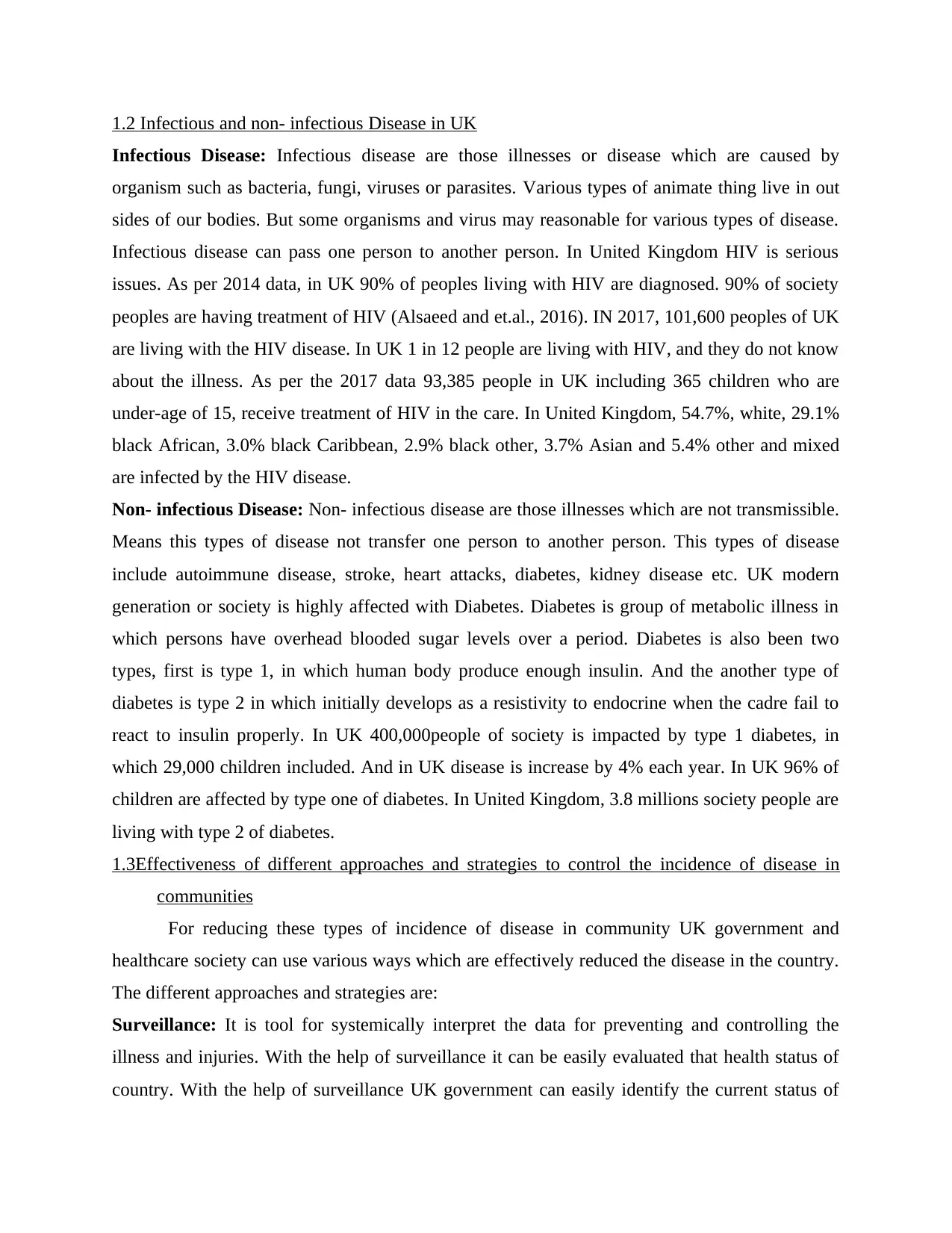
1.2 Infectious and non- infectious Disease in UK
Infectious Disease: Infectious disease are those illnesses or disease which are caused by
organism such as bacteria, fungi, viruses or parasites. Various types of animate thing live in out
sides of our bodies. But some organisms and virus may reasonable for various types of disease.
Infectious disease can pass one person to another person. In United Kingdom HIV is serious
issues. As per 2014 data, in UK 90% of peoples living with HIV are diagnosed. 90% of society
peoples are having treatment of HIV (Alsaeed and et.al., 2016). IN 2017, 101,600 peoples of UK
are living with the HIV disease. In UK 1 in 12 people are living with HIV, and they do not know
about the illness. As per the 2017 data 93,385 people in UK including 365 children who are
under-age of 15, receive treatment of HIV in the care. In United Kingdom, 54.7%, white, 29.1%
black African, 3.0% black Caribbean, 2.9% black other, 3.7% Asian and 5.4% other and mixed
are infected by the HIV disease.
Non- infectious Disease: Non- infectious disease are those illnesses which are not transmissible.
Means this types of disease not transfer one person to another person. This types of disease
include autoimmune disease, stroke, heart attacks, diabetes, kidney disease etc. UK modern
generation or society is highly affected with Diabetes. Diabetes is group of metabolic illness in
which persons have overhead blooded sugar levels over a period. Diabetes is also been two
types, first is type 1, in which human body produce enough insulin. And the another type of
diabetes is type 2 in which initially develops as a resistivity to endocrine when the cadre fail to
react to insulin properly. In UK 400,000people of society is impacted by type 1 diabetes, in
which 29,000 children included. And in UK disease is increase by 4% each year. In UK 96% of
children are affected by type one of diabetes. In United Kingdom, 3.8 millions society people are
living with type 2 of diabetes.
1.3Effectiveness of different approaches and strategies to control the incidence of disease in
communities
For reducing these types of incidence of disease in community UK government and
healthcare society can use various ways which are effectively reduced the disease in the country.
The different approaches and strategies are:
Surveillance: It is tool for systemically interpret the data for preventing and controlling the
illness and injuries. With the help of surveillance it can be easily evaluated that health status of
country. With the help of surveillance UK government can easily identify the current status of
Infectious Disease: Infectious disease are those illnesses or disease which are caused by
organism such as bacteria, fungi, viruses or parasites. Various types of animate thing live in out
sides of our bodies. But some organisms and virus may reasonable for various types of disease.
Infectious disease can pass one person to another person. In United Kingdom HIV is serious
issues. As per 2014 data, in UK 90% of peoples living with HIV are diagnosed. 90% of society
peoples are having treatment of HIV (Alsaeed and et.al., 2016). IN 2017, 101,600 peoples of UK
are living with the HIV disease. In UK 1 in 12 people are living with HIV, and they do not know
about the illness. As per the 2017 data 93,385 people in UK including 365 children who are
under-age of 15, receive treatment of HIV in the care. In United Kingdom, 54.7%, white, 29.1%
black African, 3.0% black Caribbean, 2.9% black other, 3.7% Asian and 5.4% other and mixed
are infected by the HIV disease.
Non- infectious Disease: Non- infectious disease are those illnesses which are not transmissible.
Means this types of disease not transfer one person to another person. This types of disease
include autoimmune disease, stroke, heart attacks, diabetes, kidney disease etc. UK modern
generation or society is highly affected with Diabetes. Diabetes is group of metabolic illness in
which persons have overhead blooded sugar levels over a period. Diabetes is also been two
types, first is type 1, in which human body produce enough insulin. And the another type of
diabetes is type 2 in which initially develops as a resistivity to endocrine when the cadre fail to
react to insulin properly. In UK 400,000people of society is impacted by type 1 diabetes, in
which 29,000 children included. And in UK disease is increase by 4% each year. In UK 96% of
children are affected by type one of diabetes. In United Kingdom, 3.8 millions society people are
living with type 2 of diabetes.
1.3Effectiveness of different approaches and strategies to control the incidence of disease in
communities
For reducing these types of incidence of disease in community UK government and
healthcare society can use various ways which are effectively reduced the disease in the country.
The different approaches and strategies are:
Surveillance: It is tool for systemically interpret the data for preventing and controlling the
illness and injuries. With the help of surveillance it can be easily evaluated that health status of
country. With the help of surveillance UK government can easily identify the current status of
Paraphrase This Document
Need a fresh take? Get an instant paraphrase of this document with our AI Paraphraser

illness and injuries in the country (Zestcott, Blair and Stone,2016). It is helpful for find out the
new disease in the country. It is provided information about upcoming disease in the society.
Screening: With the help of method screening UK authorities is easily evaluated the different
level and qualities of disease. Such as it will help of identify different disease tuberculosis,
cancer, diarrhoea etc. With the help of authorities of UK can know about that what type of
diseases are currently available in the state.
Immunization: Immunization is the very important for the control the incidence of disease in
the communities. According to immunization authorities of UK strictly focus on improve the
immunity in the society people (Bradley, Sipsma and Taylor, 2016). It will improve the
immunization system of society, and they are not affected by the diseases.
Education and awareness: UK authorities will also focus on the education and awareness
program to reduce the disease ration in community. If society people have knowledge about the
illness they are able to prevent their self from those diseases.
Social care centres: Authorities of UK can also focus upon social care centre for educate the
people and reduce the disease (Bradley, Sipsma and Taylor, 2016). UK's government can design
the social and medical camps for the solving injuries of society people.
Environmental controls: The main duty of environmental controls not only the safety of
environment but also the safety and security of society peoples. It is controlling the various
disease which are entered the society.
LO2
2.1 Current priorities and approaches to the provision of services of people with disease or illness
There are some very crucial diseases and illness which are prevented as the priorities of
health and social care services such as cancer, diabetes, obesity etc. HIV is the very crucial and
danger disease that will affect various people in the world and also most of the peoples of UK is
impacted with the HIV. It is the priority of health and medical services that provides programs
and treatment that will reduce the ratio of HIV. The disease of HIV can be prevented by the two
ways i.e.:
Primary Prevention: Primary prevention means those methods and awareness program by
which society disease can be reduce and also enhance the knowledge of society people for
preventing the disease at the primary level. UK government for HIV disease also design some
program which is CHAPS and second one is NAHIP. CHAP is the major program which is
new disease in the country. It is provided information about upcoming disease in the society.
Screening: With the help of method screening UK authorities is easily evaluated the different
level and qualities of disease. Such as it will help of identify different disease tuberculosis,
cancer, diarrhoea etc. With the help of authorities of UK can know about that what type of
diseases are currently available in the state.
Immunization: Immunization is the very important for the control the incidence of disease in
the communities. According to immunization authorities of UK strictly focus on improve the
immunity in the society people (Bradley, Sipsma and Taylor, 2016). It will improve the
immunization system of society, and they are not affected by the diseases.
Education and awareness: UK authorities will also focus on the education and awareness
program to reduce the disease ration in community. If society people have knowledge about the
illness they are able to prevent their self from those diseases.
Social care centres: Authorities of UK can also focus upon social care centre for educate the
people and reduce the disease (Bradley, Sipsma and Taylor, 2016). UK's government can design
the social and medical camps for the solving injuries of society people.
Environmental controls: The main duty of environmental controls not only the safety of
environment but also the safety and security of society peoples. It is controlling the various
disease which are entered the society.
LO2
2.1 Current priorities and approaches to the provision of services of people with disease or illness
There are some very crucial diseases and illness which are prevented as the priorities of
health and social care services such as cancer, diabetes, obesity etc. HIV is the very crucial and
danger disease that will affect various people in the world and also most of the peoples of UK is
impacted with the HIV. It is the priority of health and medical services that provides programs
and treatment that will reduce the ratio of HIV. The disease of HIV can be prevented by the two
ways i.e.:
Primary Prevention: Primary prevention means those methods and awareness program by
which society disease can be reduce and also enhance the knowledge of society people for
preventing the disease at the primary level. UK government for HIV disease also design some
program which is CHAPS and second one is NAHIP. CHAP is the major program which is
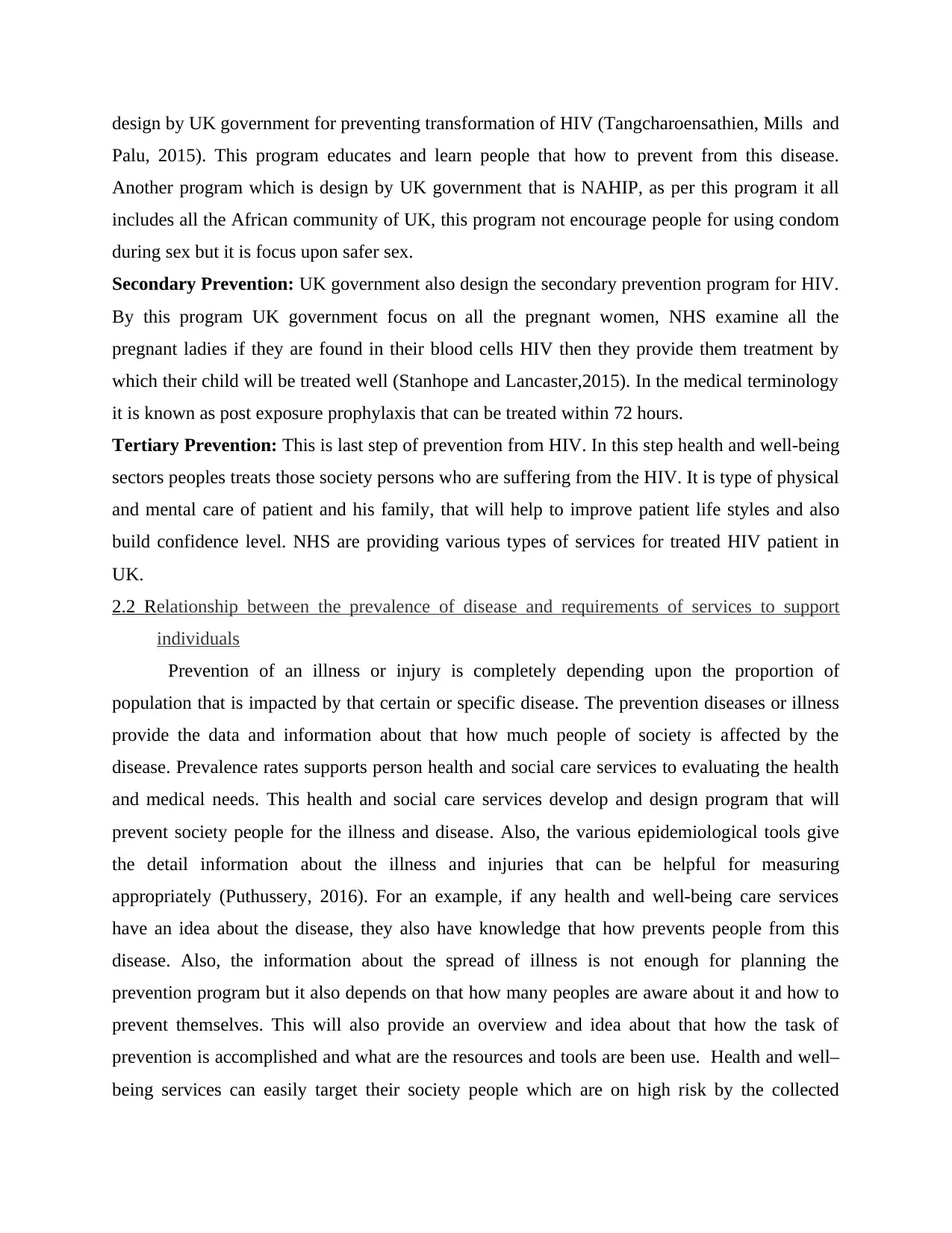
design by UK government for preventing transformation of HIV (Tangcharoensathien, Mills and
Palu, 2015). This program educates and learn people that how to prevent from this disease.
Another program which is design by UK government that is NAHIP, as per this program it all
includes all the African community of UK, this program not encourage people for using condom
during sex but it is focus upon safer sex.
Secondary Prevention: UK government also design the secondary prevention program for HIV.
By this program UK government focus on all the pregnant women, NHS examine all the
pregnant ladies if they are found in their blood cells HIV then they provide them treatment by
which their child will be treated well (Stanhope and Lancaster,2015). In the medical terminology
it is known as post exposure prophylaxis that can be treated within 72 hours.
Tertiary Prevention: This is last step of prevention from HIV. In this step health and well-being
sectors peoples treats those society persons who are suffering from the HIV. It is type of physical
and mental care of patient and his family, that will help to improve patient life styles and also
build confidence level. NHS are providing various types of services for treated HIV patient in
UK.
2.2 Relationship between the prevalence of disease and requirements of services to support
individuals
Prevention of an illness or injury is completely depending upon the proportion of
population that is impacted by that certain or specific disease. The prevention diseases or illness
provide the data and information about that how much people of society is affected by the
disease. Prevalence rates supports person health and social care services to evaluating the health
and medical needs. This health and social care services develop and design program that will
prevent society people for the illness and disease. Also, the various epidemiological tools give
the detail information about the illness and injuries that can be helpful for measuring
appropriately (Puthussery, 2016). For an example, if any health and well-being care services
have an idea about the disease, they also have knowledge that how prevents people from this
disease. Also, the information about the spread of illness is not enough for planning the
prevention program but it also depends on that how many peoples are aware about it and how to
prevent themselves. This will also provide an overview and idea about that how the task of
prevention is accomplished and what are the resources and tools are been use. Health and well–
being services can easily target their society people which are on high risk by the collected
Palu, 2015). This program educates and learn people that how to prevent from this disease.
Another program which is design by UK government that is NAHIP, as per this program it all
includes all the African community of UK, this program not encourage people for using condom
during sex but it is focus upon safer sex.
Secondary Prevention: UK government also design the secondary prevention program for HIV.
By this program UK government focus on all the pregnant women, NHS examine all the
pregnant ladies if they are found in their blood cells HIV then they provide them treatment by
which their child will be treated well (Stanhope and Lancaster,2015). In the medical terminology
it is known as post exposure prophylaxis that can be treated within 72 hours.
Tertiary Prevention: This is last step of prevention from HIV. In this step health and well-being
sectors peoples treats those society persons who are suffering from the HIV. It is type of physical
and mental care of patient and his family, that will help to improve patient life styles and also
build confidence level. NHS are providing various types of services for treated HIV patient in
UK.
2.2 Relationship between the prevalence of disease and requirements of services to support
individuals
Prevention of an illness or injury is completely depending upon the proportion of
population that is impacted by that certain or specific disease. The prevention diseases or illness
provide the data and information about that how much people of society is affected by the
disease. Prevalence rates supports person health and social care services to evaluating the health
and medical needs. This health and social care services develop and design program that will
prevent society people for the illness and disease. Also, the various epidemiological tools give
the detail information about the illness and injuries that can be helpful for measuring
appropriately (Puthussery, 2016). For an example, if any health and well-being care services
have an idea about the disease, they also have knowledge that how prevents people from this
disease. Also, the information about the spread of illness is not enough for planning the
prevention program but it also depends on that how many peoples are aware about it and how to
prevent themselves. This will also provide an overview and idea about that how the task of
prevention is accomplished and what are the resources and tools are been use. Health and well–
being services can easily target their society people which are on high risk by the collected
⊘ This is a preview!⊘
Do you want full access?
Subscribe today to unlock all pages.

Trusted by 1+ million students worldwide

information. So, for the solving and preventing any kind of illness, disease and requirements of
services are very necessary. Without effective data and information health and well-being
services are unable to solve the major problem of society.
2.3 The impact of current lifestyles choices on the future needs for health and social care services
Various factors and elements are available in market that will affect the health of people
such as their eating habits, working culture, exercising etc. All the factors sometimes the become
the reasons of disease and illness of an individual (Gadsby and et.al., 2017). Many health-related
problems are risen just because of individual habits such as alcohols, drugs and various harmful
substances. In UK two very serious health problem is found that is intake of drugs and obesity.
Both are increasing just because their lifestyles.
Obesity: The main reason behind the obesity is the eating habits of an individual. Wrong and
unhealthy food which is not contained nutrient are lead to fat in the body that outcome is obesity.
As per the relent data and information it can be found that premature adults' death ratio can be
goes down to 8% if persons of society are focus upon the health diet (Conklin, Morris and Nolte,
2015). The survey results present that 13% men and 10% are women are going through the
obesity from 1993 to 2010. There are various reason to increasing the rate of Obese people in
UK i.e.:
Poor Diet: The improving disease in the UK society is the main reason is their poor diet. Peoples
of UK are not taking right diet which is healthy and nutrient. They eat a lot of junk food which
may lead the fat and also impacted the health of society peoples. If the people of UK is getting
right and effective diet than their health improve, and they also improve their immune system by
which they can protect themselves by the dangerous diseases. But the culture of UK is just
different.
Consumption of alcohol: The another reason by which UK society people health is impacted
that is the hight consumption of alcohol. Because it is the culture and trend of UK society of
consumption of high rate of alcohol which may impact their health and these problems leads to
various disease in the society of UK. UK young and aged peoples both are consumed high level
of alcohol which is very dangerous for their health.
Lifestyles: The another reason of bad health of UK society people is their bad lifestyles. There is
no timing of sleep, exercise, jogging etc. these all things directly or indirectly impacted the
services are very necessary. Without effective data and information health and well-being
services are unable to solve the major problem of society.
2.3 The impact of current lifestyles choices on the future needs for health and social care services
Various factors and elements are available in market that will affect the health of people
such as their eating habits, working culture, exercising etc. All the factors sometimes the become
the reasons of disease and illness of an individual (Gadsby and et.al., 2017). Many health-related
problems are risen just because of individual habits such as alcohols, drugs and various harmful
substances. In UK two very serious health problem is found that is intake of drugs and obesity.
Both are increasing just because their lifestyles.
Obesity: The main reason behind the obesity is the eating habits of an individual. Wrong and
unhealthy food which is not contained nutrient are lead to fat in the body that outcome is obesity.
As per the relent data and information it can be found that premature adults' death ratio can be
goes down to 8% if persons of society are focus upon the health diet (Conklin, Morris and Nolte,
2015). The survey results present that 13% men and 10% are women are going through the
obesity from 1993 to 2010. There are various reason to increasing the rate of Obese people in
UK i.e.:
Poor Diet: The improving disease in the UK society is the main reason is their poor diet. Peoples
of UK are not taking right diet which is healthy and nutrient. They eat a lot of junk food which
may lead the fat and also impacted the health of society peoples. If the people of UK is getting
right and effective diet than their health improve, and they also improve their immune system by
which they can protect themselves by the dangerous diseases. But the culture of UK is just
different.
Consumption of alcohol: The another reason by which UK society people health is impacted
that is the hight consumption of alcohol. Because it is the culture and trend of UK society of
consumption of high rate of alcohol which may impact their health and these problems leads to
various disease in the society of UK. UK young and aged peoples both are consumed high level
of alcohol which is very dangerous for their health.
Lifestyles: The another reason of bad health of UK society people is their bad lifestyles. There is
no timing of sleep, exercise, jogging etc. these all things directly or indirectly impacted the
Paraphrase This Document
Need a fresh take? Get an instant paraphrase of this document with our AI Paraphraser

health of society people (Chen and et.al., 2016). The health of society people of UK impacted
badly by the same lifestyles.
Drugs: Drugs is also the main reason of bad life of UK peoples. Because the youth of UK is
consume lots of drugs which is dangerous for their health and lead the problems like stress,
addictions, anxiety in the youth of UK.
LO3
3.1 The health and well-being priorities for individuals
The health and well-being priorities very useful for public health. With the help of these
activities individual feel mental and physical peace. The basic priorities for individual in health
and well-being priorities these are:
Safety and security: Health and well-being are responsible for diabetes patients safety and
securities in UK. They are provided them safety and supplements for their health. With the help
of safety and security diabetic patient feel happy, secure and physically fit. United Kingdom
government design safety and security policies such as parliamentary health and well-being
services, the house of common health and safety committee etc.
Mobility: UK government also provide the facilities of mobility and transportation to their
diabetic patients. The influence of transport choices on people's mental and physical health and
well-being should be emphasized more in policy and practice (Beard and Bloom, 2015). The
sectors of health care and well-being provide the facilities of mobility top their patient which can
help them easily reach by one place to another place.
Diet: The another basic requirement of diabetic patient is the proper diet. Because in diabetes
disease taking quality and nutrient diet is very important (Bradley and et.al., 2016). It will also
help patient for maintaining the diabetes problem and also control the insulin level in diabetes
patients.
Hygiene: Hygiene is also very important thing any type of illness or injuries (Brownson, Colditz
and Proctor, 2018). Maintaining cleanlinesses and hygiene make patient health strong and the
chances of get well soon is also improved. So, health and well-being society also provide their
diabetic patient the facilities of hygiene in the hospitals and welfare care centres.
3.2 Effectiveness of strategies, systems and policies in a health or social care settings
Policies of care UK care homes: UK care homes are play significant roles in health and well-
being services. They are performing their task as per the rules and norms of government. They
badly by the same lifestyles.
Drugs: Drugs is also the main reason of bad life of UK peoples. Because the youth of UK is
consume lots of drugs which is dangerous for their health and lead the problems like stress,
addictions, anxiety in the youth of UK.
LO3
3.1 The health and well-being priorities for individuals
The health and well-being priorities very useful for public health. With the help of these
activities individual feel mental and physical peace. The basic priorities for individual in health
and well-being priorities these are:
Safety and security: Health and well-being are responsible for diabetes patients safety and
securities in UK. They are provided them safety and supplements for their health. With the help
of safety and security diabetic patient feel happy, secure and physically fit. United Kingdom
government design safety and security policies such as parliamentary health and well-being
services, the house of common health and safety committee etc.
Mobility: UK government also provide the facilities of mobility and transportation to their
diabetic patients. The influence of transport choices on people's mental and physical health and
well-being should be emphasized more in policy and practice (Beard and Bloom, 2015). The
sectors of health care and well-being provide the facilities of mobility top their patient which can
help them easily reach by one place to another place.
Diet: The another basic requirement of diabetic patient is the proper diet. Because in diabetes
disease taking quality and nutrient diet is very important (Bradley and et.al., 2016). It will also
help patient for maintaining the diabetes problem and also control the insulin level in diabetes
patients.
Hygiene: Hygiene is also very important thing any type of illness or injuries (Brownson, Colditz
and Proctor, 2018). Maintaining cleanlinesses and hygiene make patient health strong and the
chances of get well soon is also improved. So, health and well-being society also provide their
diabetic patient the facilities of hygiene in the hospitals and welfare care centres.
3.2 Effectiveness of strategies, systems and policies in a health or social care settings
Policies of care UK care homes: UK care homes are play significant roles in health and well-
being services. They are performing their task as per the rules and norms of government. They
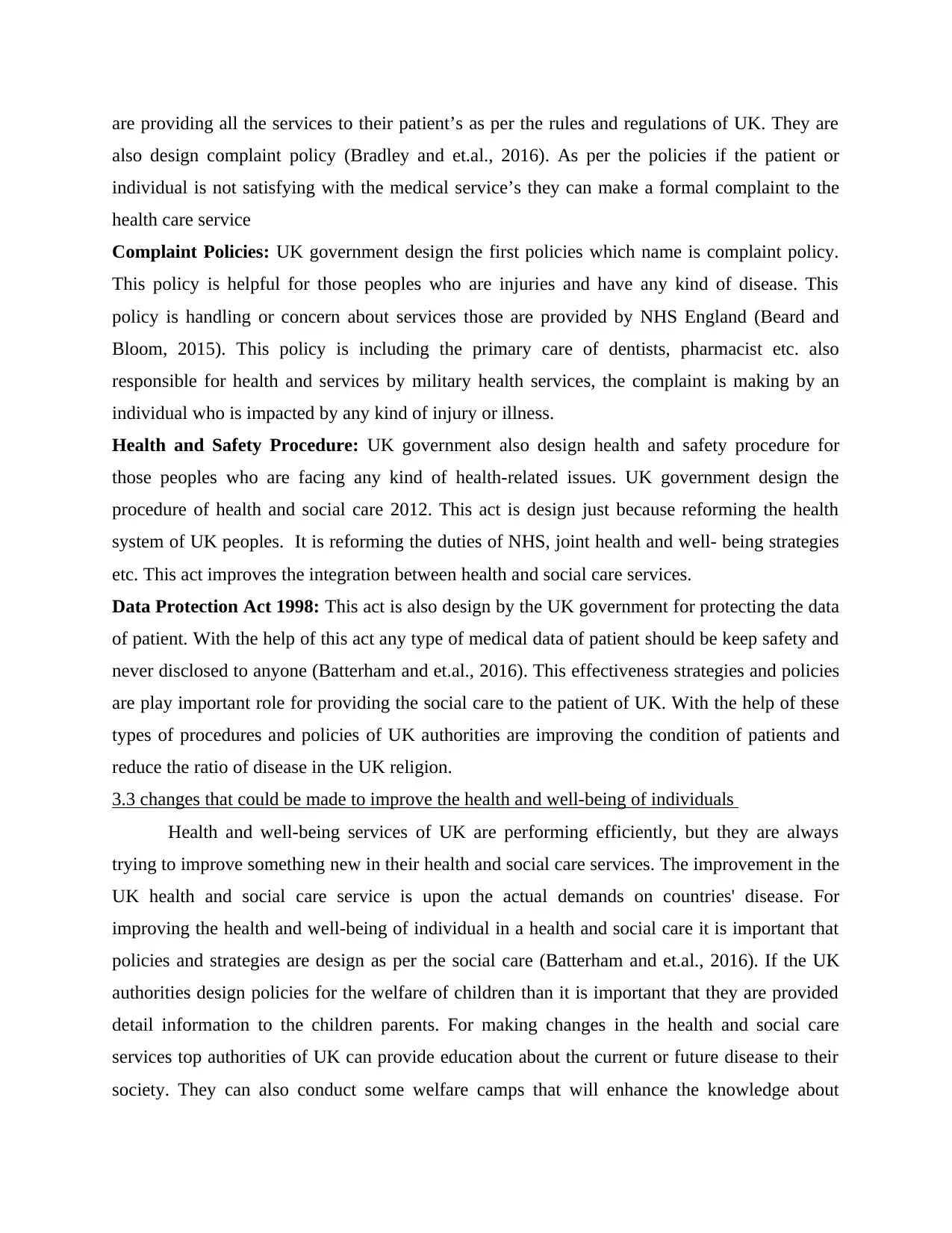
are providing all the services to their patient’s as per the rules and regulations of UK. They are
also design complaint policy (Bradley and et.al., 2016). As per the policies if the patient or
individual is not satisfying with the medical service’s they can make a formal complaint to the
health care service
Complaint Policies: UK government design the first policies which name is complaint policy.
This policy is helpful for those peoples who are injuries and have any kind of disease. This
policy is handling or concern about services those are provided by NHS England (Beard and
Bloom, 2015). This policy is including the primary care of dentists, pharmacist etc. also
responsible for health and services by military health services, the complaint is making by an
individual who is impacted by any kind of injury or illness.
Health and Safety Procedure: UK government also design health and safety procedure for
those peoples who are facing any kind of health-related issues. UK government design the
procedure of health and social care 2012. This act is design just because reforming the health
system of UK peoples. It is reforming the duties of NHS, joint health and well- being strategies
etc. This act improves the integration between health and social care services.
Data Protection Act 1998: This act is also design by the UK government for protecting the data
of patient. With the help of this act any type of medical data of patient should be keep safety and
never disclosed to anyone (Batterham and et.al., 2016). This effectiveness strategies and policies
are play important role for providing the social care to the patient of UK. With the help of these
types of procedures and policies of UK authorities are improving the condition of patients and
reduce the ratio of disease in the UK religion.
3.3 changes that could be made to improve the health and well-being of individuals
Health and well-being services of UK are performing efficiently, but they are always
trying to improve something new in their health and social care services. The improvement in the
UK health and social care service is upon the actual demands on countries' disease. For
improving the health and well-being of individual in a health and social care it is important that
policies and strategies are design as per the social care (Batterham and et.al., 2016). If the UK
authorities design policies for the welfare of children than it is important that they are provided
detail information to the children parents. For making changes in the health and social care
services top authorities of UK can provide education about the current or future disease to their
society. They can also conduct some welfare camps that will enhance the knowledge about
also design complaint policy (Bradley and et.al., 2016). As per the policies if the patient or
individual is not satisfying with the medical service’s they can make a formal complaint to the
health care service
Complaint Policies: UK government design the first policies which name is complaint policy.
This policy is helpful for those peoples who are injuries and have any kind of disease. This
policy is handling or concern about services those are provided by NHS England (Beard and
Bloom, 2015). This policy is including the primary care of dentists, pharmacist etc. also
responsible for health and services by military health services, the complaint is making by an
individual who is impacted by any kind of injury or illness.
Health and Safety Procedure: UK government also design health and safety procedure for
those peoples who are facing any kind of health-related issues. UK government design the
procedure of health and social care 2012. This act is design just because reforming the health
system of UK peoples. It is reforming the duties of NHS, joint health and well- being strategies
etc. This act improves the integration between health and social care services.
Data Protection Act 1998: This act is also design by the UK government for protecting the data
of patient. With the help of this act any type of medical data of patient should be keep safety and
never disclosed to anyone (Batterham and et.al., 2016). This effectiveness strategies and policies
are play important role for providing the social care to the patient of UK. With the help of these
types of procedures and policies of UK authorities are improving the condition of patients and
reduce the ratio of disease in the UK religion.
3.3 changes that could be made to improve the health and well-being of individuals
Health and well-being services of UK are performing efficiently, but they are always
trying to improve something new in their health and social care services. The improvement in the
UK health and social care service is upon the actual demands on countries' disease. For
improving the health and well-being of individual in a health and social care it is important that
policies and strategies are design as per the social care (Batterham and et.al., 2016). If the UK
authorities design policies for the welfare of children than it is important that they are provided
detail information to the children parents. For making changes in the health and social care
services top authorities of UK can provide education about the current or future disease to their
society. They can also conduct some welfare camps that will enhance the knowledge about
⊘ This is a preview!⊘
Do you want full access?
Subscribe today to unlock all pages.

Trusted by 1+ million students worldwide
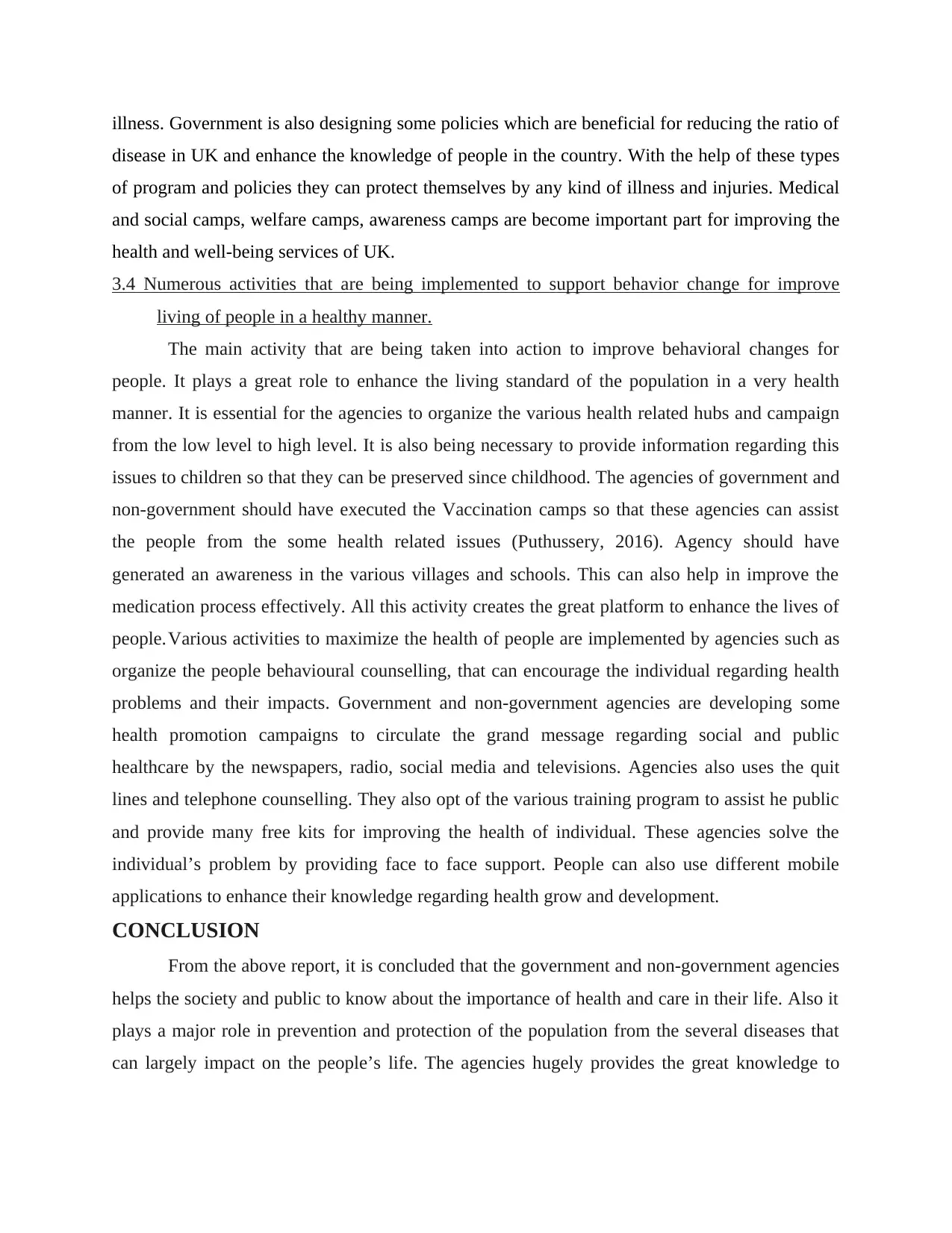
illness. Government is also designing some policies which are beneficial for reducing the ratio of
disease in UK and enhance the knowledge of people in the country. With the help of these types
of program and policies they can protect themselves by any kind of illness and injuries. Medical
and social camps, welfare camps, awareness camps are become important part for improving the
health and well-being services of UK.
3.4 Numerous activities that are being implemented to support behavior change for improve
living of people in a healthy manner.
The main activity that are being taken into action to improve behavioral changes for
people. It plays a great role to enhance the living standard of the population in a very health
manner. It is essential for the agencies to organize the various health related hubs and campaign
from the low level to high level. It is also being necessary to provide information regarding this
issues to children so that they can be preserved since childhood. The agencies of government and
non-government should have executed the Vaccination camps so that these agencies can assist
the people from the some health related issues (Puthussery, 2016). Agency should have
generated an awareness in the various villages and schools. This can also help in improve the
medication process effectively. All this activity creates the great platform to enhance the lives of
people.Various activities to maximize the health of people are implemented by agencies such as
organize the people behavioural counselling, that can encourage the individual regarding health
problems and their impacts. Government and non-government agencies are developing some
health promotion campaigns to circulate the grand message regarding social and public
healthcare by the newspapers, radio, social media and televisions. Agencies also uses the quit
lines and telephone counselling. They also opt of the various training program to assist he public
and provide many free kits for improving the health of individual. These agencies solve the
individual’s problem by providing face to face support. People can also use different mobile
applications to enhance their knowledge regarding health grow and development.
CONCLUSION
From the above report, it is concluded that the government and non-government agencies
helps the society and public to know about the importance of health and care in their life. Also it
plays a major role in prevention and protection of the population from the several diseases that
can largely impact on the people’s life. The agencies hugely provides the great knowledge to
disease in UK and enhance the knowledge of people in the country. With the help of these types
of program and policies they can protect themselves by any kind of illness and injuries. Medical
and social camps, welfare camps, awareness camps are become important part for improving the
health and well-being services of UK.
3.4 Numerous activities that are being implemented to support behavior change for improve
living of people in a healthy manner.
The main activity that are being taken into action to improve behavioral changes for
people. It plays a great role to enhance the living standard of the population in a very health
manner. It is essential for the agencies to organize the various health related hubs and campaign
from the low level to high level. It is also being necessary to provide information regarding this
issues to children so that they can be preserved since childhood. The agencies of government and
non-government should have executed the Vaccination camps so that these agencies can assist
the people from the some health related issues (Puthussery, 2016). Agency should have
generated an awareness in the various villages and schools. This can also help in improve the
medication process effectively. All this activity creates the great platform to enhance the lives of
people.Various activities to maximize the health of people are implemented by agencies such as
organize the people behavioural counselling, that can encourage the individual regarding health
problems and their impacts. Government and non-government agencies are developing some
health promotion campaigns to circulate the grand message regarding social and public
healthcare by the newspapers, radio, social media and televisions. Agencies also uses the quit
lines and telephone counselling. They also opt of the various training program to assist he public
and provide many free kits for improving the health of individual. These agencies solve the
individual’s problem by providing face to face support. People can also use different mobile
applications to enhance their knowledge regarding health grow and development.
CONCLUSION
From the above report, it is concluded that the government and non-government agencies
helps the society and public to know about the importance of health and care in their life. Also it
plays a major role in prevention and protection of the population from the several diseases that
can largely impact on the people’s life. The agencies hugely provides the great knowledge to
Paraphrase This Document
Need a fresh take? Get an instant paraphrase of this document with our AI Paraphraser

identify the health and disease level in communities. Strategies and approaches plays a crucial
role to control the enlargement of disease in the environment.
role to control the enlargement of disease in the environment.
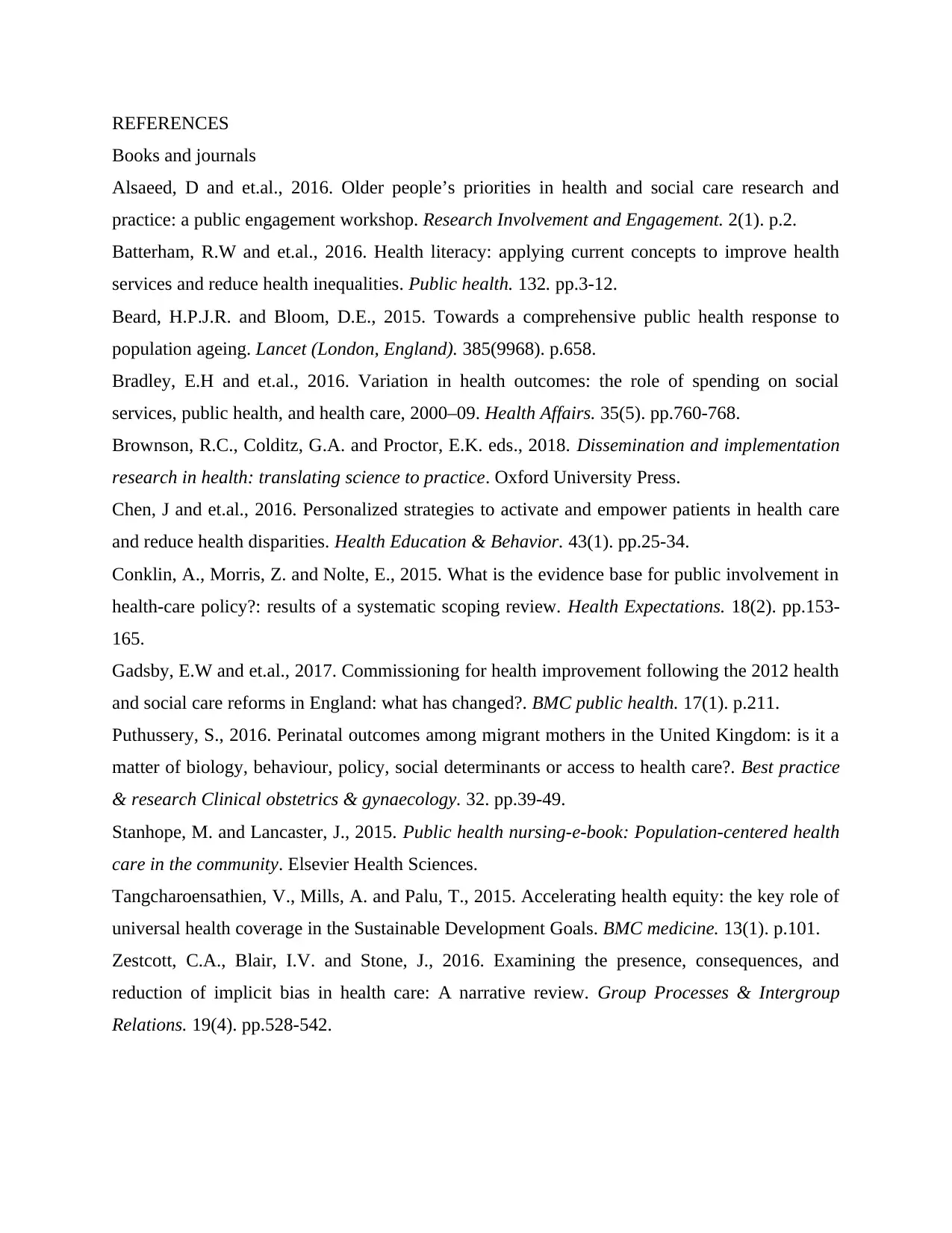
REFERENCES
Books and journals
Alsaeed, D and et.al., 2016. Older people’s priorities in health and social care research and
practice: a public engagement workshop. Research Involvement and Engagement. 2(1). p.2.
Batterham, R.W and et.al., 2016. Health literacy: applying current concepts to improve health
services and reduce health inequalities. Public health. 132. pp.3-12.
Beard, H.P.J.R. and Bloom, D.E., 2015. Towards a comprehensive public health response to
population ageing. Lancet (London, England). 385(9968). p.658.
Bradley, E.H and et.al., 2016. Variation in health outcomes: the role of spending on social
services, public health, and health care, 2000–09. Health Affairs. 35(5). pp.760-768.
Brownson, R.C., Colditz, G.A. and Proctor, E.K. eds., 2018. Dissemination and implementation
research in health: translating science to practice. Oxford University Press.
Chen, J and et.al., 2016. Personalized strategies to activate and empower patients in health care
and reduce health disparities. Health Education & Behavior. 43(1). pp.25-34.
Conklin, A., Morris, Z. and Nolte, E., 2015. What is the evidence base for public involvement in
health‐care policy?: results of a systematic scoping review. Health Expectations. 18(2). pp.153-
165.
Gadsby, E.W and et.al., 2017. Commissioning for health improvement following the 2012 health
and social care reforms in England: what has changed?. BMC public health. 17(1). p.211.
Puthussery, S., 2016. Perinatal outcomes among migrant mothers in the United Kingdom: is it a
matter of biology, behaviour, policy, social determinants or access to health care?. Best practice
& research Clinical obstetrics & gynaecology. 32. pp.39-49.
Stanhope, M. and Lancaster, J., 2015. Public health nursing-e-book: Population-centered health
care in the community. Elsevier Health Sciences.
Tangcharoensathien, V., Mills, A. and Palu, T., 2015. Accelerating health equity: the key role of
universal health coverage in the Sustainable Development Goals. BMC medicine. 13(1). p.101.
Zestcott, C.A., Blair, I.V. and Stone, J., 2016. Examining the presence, consequences, and
reduction of implicit bias in health care: A narrative review. Group Processes & Intergroup
Relations. 19(4). pp.528-542.
Books and journals
Alsaeed, D and et.al., 2016. Older people’s priorities in health and social care research and
practice: a public engagement workshop. Research Involvement and Engagement. 2(1). p.2.
Batterham, R.W and et.al., 2016. Health literacy: applying current concepts to improve health
services and reduce health inequalities. Public health. 132. pp.3-12.
Beard, H.P.J.R. and Bloom, D.E., 2015. Towards a comprehensive public health response to
population ageing. Lancet (London, England). 385(9968). p.658.
Bradley, E.H and et.al., 2016. Variation in health outcomes: the role of spending on social
services, public health, and health care, 2000–09. Health Affairs. 35(5). pp.760-768.
Brownson, R.C., Colditz, G.A. and Proctor, E.K. eds., 2018. Dissemination and implementation
research in health: translating science to practice. Oxford University Press.
Chen, J and et.al., 2016. Personalized strategies to activate and empower patients in health care
and reduce health disparities. Health Education & Behavior. 43(1). pp.25-34.
Conklin, A., Morris, Z. and Nolte, E., 2015. What is the evidence base for public involvement in
health‐care policy?: results of a systematic scoping review. Health Expectations. 18(2). pp.153-
165.
Gadsby, E.W and et.al., 2017. Commissioning for health improvement following the 2012 health
and social care reforms in England: what has changed?. BMC public health. 17(1). p.211.
Puthussery, S., 2016. Perinatal outcomes among migrant mothers in the United Kingdom: is it a
matter of biology, behaviour, policy, social determinants or access to health care?. Best practice
& research Clinical obstetrics & gynaecology. 32. pp.39-49.
Stanhope, M. and Lancaster, J., 2015. Public health nursing-e-book: Population-centered health
care in the community. Elsevier Health Sciences.
Tangcharoensathien, V., Mills, A. and Palu, T., 2015. Accelerating health equity: the key role of
universal health coverage in the Sustainable Development Goals. BMC medicine. 13(1). p.101.
Zestcott, C.A., Blair, I.V. and Stone, J., 2016. Examining the presence, consequences, and
reduction of implicit bias in health care: A narrative review. Group Processes & Intergroup
Relations. 19(4). pp.528-542.
⊘ This is a preview!⊘
Do you want full access?
Subscribe today to unlock all pages.

Trusted by 1+ million students worldwide
1 out of 13
Related Documents
Your All-in-One AI-Powered Toolkit for Academic Success.
+13062052269
info@desklib.com
Available 24*7 on WhatsApp / Email
![[object Object]](/_next/static/media/star-bottom.7253800d.svg)
Unlock your academic potential
Copyright © 2020–2025 A2Z Services. All Rights Reserved. Developed and managed by ZUCOL.





